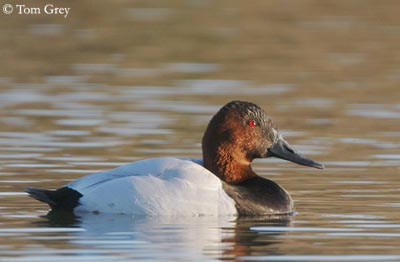
Canvasback
Aythya valisineria
Anseriforme Order – Anatidae Family
BIOMETRICS:
Length: 48 à 56 cm
Wingspan: 79 à 89 cm
Weight: 860 à 1600 g
LONGEVITY: Up to 22 years
DESCRIPTION:
Canvasback is a large diving duck.

Adult male has pale grey back, white belly and black chest. Upper back is black. Rump and upper tail are finely vermiculated with black. Upper wing is white and under wing is slate grey.
Head and neck are bright chestnut and profile shows sloping forehead and pointed crown. Long, blackish bill is slightly bulbous at base. Eyes are red, duller in winter. Legs and feet are bluish grey.
Canvasback male in winter plumage is duller and resembles female.
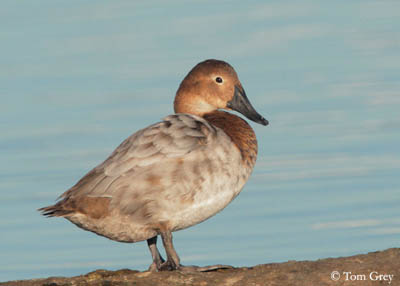
Adult female has similar silhouette. Her plumage is duller, less colourful than male. She has white belly, pale brown back and reddish-brown head, neck and chest. Eyes are dark brown. She is smaller than male.
Juvenile of both sexes resemble adult female, but they have darker back plumage and mottled breast. Eyes are yellowish.
Later in the year, young male resembles adult, and by February, both sexes have complete plumage, as soon as the first winter.
Canvasback resembles Redhead (Aythya Americana) and Common Pochard (Aythya farina), but it may be distinguished by large black bill and sloping forehead.
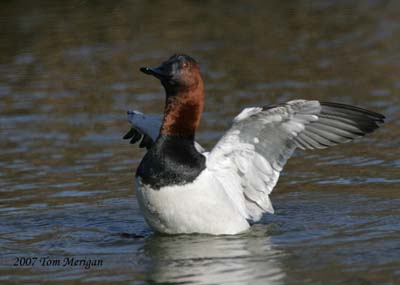
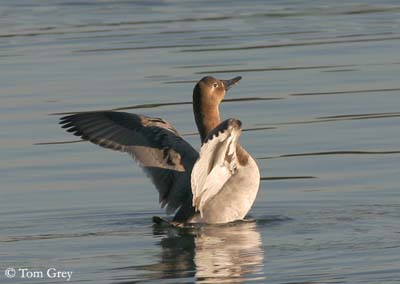
VOICE: SOUNDS BY XENO-CANTO
Canvasback is silent outside of breeding season, but during courtship displays, male utters a dove-like “ik-ik-cooo” call. Female often answers with a low quacking “cuk-cuk”.
HABITAT:
Canvasback breeds in open marshes with dense fringing vegetation and in wetlands. It winters near lakes, coastal lagoons, sheltered bays and estuaries.
RANGE:
Canvasback breeds in North America, in the United States, northern Great Plains, Alaska and Western Canada. It is strongly migratory and winters in southern United States, in both Atlantic and Pacific coasts of US and Mexico.
BEHAVIOUR:
Canvasback feeds by dabbling on the water surface, and by diving below the surface. As other diving dicks, Canvasback has specials lobes in its hind toes, and it can use them as paddle in the water. They can dive into water 2 to 9 metres deep.
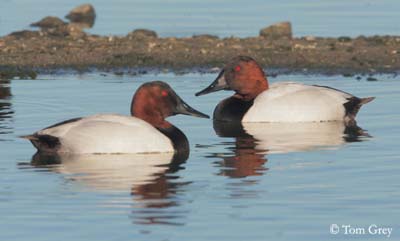
In winter grounds, Canvasback form small compact flocks, and fly together with a loud whirring noise. They spend most of their time on open water in large floating flocks.
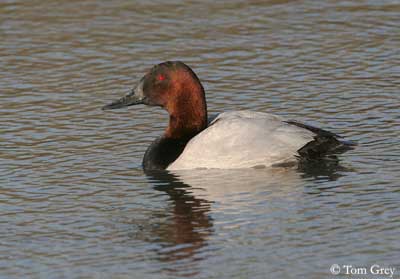
During migrations, Canvasback form flocks of up to 100 birds, and when they make stopover, they gather in very large flocks of many thousands birds.
Northern migrations occur by mid-April, and southern migration by mid-October.
Courtship displays starts by mid-February. We can often see several males with one or two females. Displays show male throwing its head back, until crown almost joins tail feathers. Then, it brings the head forwards, while it utters its dove-like call. Male may also perform other displays with neck stretched and bent forwards. Canvasback doesn’t mate for life.
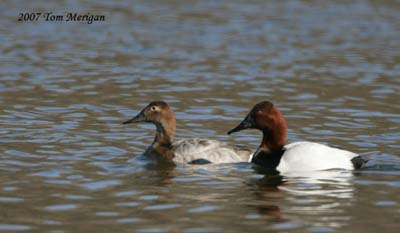
Males gather in large groups to moult, and they can’t fly during two weeks, due to loss of flight feathers. At this moment, they are vulnerable to predation. In late summer, females and young join them.
Frequency of physical interactions is highest during courtship, with pursuits, chases, fights, approach-threats with bill-jabs, pursuit flights and dives.
FLIGHT:
Canvasback is a powerful flier, able of speed of 120 km per hour. Its flight is swift and flocks fly high in V-shape formation. It has to run on the water surface, in order to take off from water, and it performs direct flight with steady, rapid wing beats.
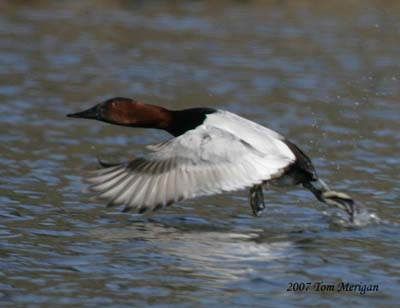
REPRODUCTION:
Canvasback female usually nests near where she was reared, relatively late in the season, about late May early June.
Nest is located near open water, in marshy areas and reedbeds. It is a bulky nest, made with reeds and sedges. Interior is lined with brown down, plucked from female body. Little by little during incubation, this down becomes an insulating blanket, and female uses it for covering the eggs when she leaves the nest.
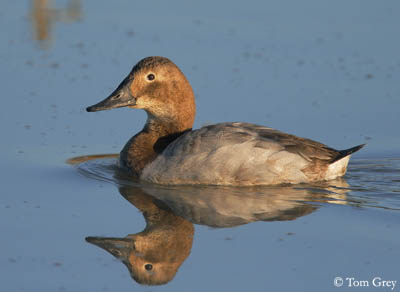
Female lays 7 to 9 dull green or greyish-olive eggs. Incubation lasts about 24 to 28 days, by female alone. Chicks leave the nest very soon, a day or two after hatching, and they find food themselves. Young need about five weeks for developing feathers, and they can fly at about 11 weeks of age.
This species produces one brood per year, but second brood may be initiated if first is destroyed.
If a predator approaches, the female silently moves off nest into water. When the brood is threatened, the female gives alarm calls and young dive or move into dense vegetation. Commons predators are mammals, corvids and gulls.
DIET:
Canvasback feeds mainly on aquatic plants such as pond weeds, wild celery, wild rice, duck potato and other flowering water vegetation.
It also consumes insects, molluscs, snails and various fish. Canvasback usually feeds by day, occasionally by night.
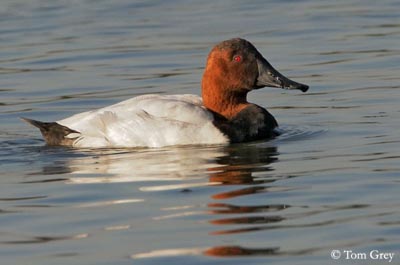
PROTECTION / THREATS / STATUS:
Canvasback is killed by hunting because its flesh is delicious, mainly when it feeds on wild celery. But in order to ensure the population numbers, Canadian and American governments regulate hunting carefully.
Canvasback is threatened by habitat loss, due to drainage of wetlands for agriculture expansion. In recent years, numbers have declined, mainly due to habitat loss.
Programs to enhance areas used by ducks and geese have been initiated in Canada, United States and Mexico.
Fr: Fuligule à dos blanc
All : Riesentafelente
Esp : Porrón Coacoxtle
Ital : Moriglione dorso di tela
Nd : Grote Tafeleend
Russe : Парусиновый нырок
Sd : Svartnäbbad brunand
Photographs by Tom Grey
His website :
Tom Grey's Bird Pictures
Photographs by Tom Merigan
His website:
Tom Meriganís Photo Galleries
Text by Nicole Bouglouan
Sources:
HANDBOOK OF THE BIRDS OF THE WORLD vol 1 by Josep del Hoyo-Andrew Elliot-Jordi Sargatal - Lynx Edicions - ISBN: 8487334105
GUIDE DES CANARDS, DES OIES ET DES CYGNES – de Steve Madge - Delachaux et Niestlé - ISBN: 2603013769
All About Birds (Cornell Lab of Ornithology)
Bird Web (Seattle Audubon Society)
What Bird-The ultimate Bird Guide (Mitchell Waite)
Wikipedia (Wikipedia, The Free Encyclopedia)